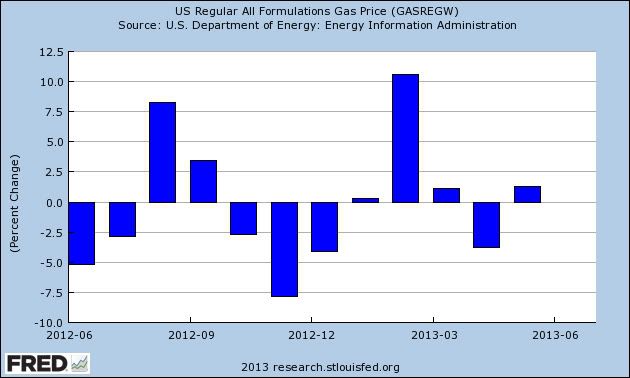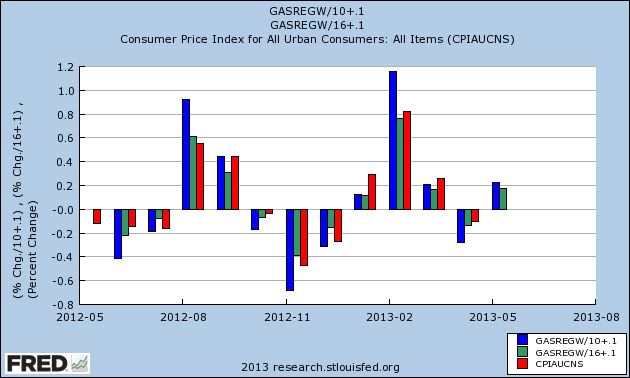John Hinderaker of the Powerline blog really wants to be taken seriously as an economic analyst.
He should really stop trying. No, really. He's
that inept.
Case in point is his latest analytical failure,
"How Bad Is Obama's Economic Record on the Economy? This Bad." He uses the NY Times articles,
"Many Rival Nations Surge Past the U.S. in Adding New Jobs." as the basis for his analysis.
The following should be noted at the start: international economic growth comparisons are extremely tricky and usually not a good idea. The reason is simple: each country is unique, making a comparison an "apples to oranges" situation. For example, comparing the US to practically any other economy runs into a problem of comparing the world's largest economy by far (the US is over twice the size of the next largest single country) to a much smaller economy. And what if the country in question is part of the south-south trade, benefiting from the commodity boom of the last 10-15 years (Canada) while the other is not? Or one country has a lower unit labor costs (Mexico) than then other? You get the point.
Also note that we're dealing with employment which is probably the most complicated economic indicator out there. As I've recently noted, Macroblog -- the blog of the Atlanta Fed -- has a much better read on this set of statistics
with its spider chart. But this level of nuance is beyond Hinderaker's capabilities.
While noting that US employment growth has lagged other countries, the Times article does a very good job of explaining why:
A big part of the problem, economists say, is just how big a hole the
American economy fell into in the first place. Not only did the global
economic downturn begin here, it also enveloped the housing market and
the banking system, sectors that were largely spared in many other
countries.
“Canada didn’t really have much of a housing bust,” Mr. Katz said.
.....
Although the construction field gained 69,000 jobs in the first five
months of 2013, with 5.8 million jobs in May, that was still nearly two
million fewer jobs than in 2007, according to the Labor Department.
Remember that at the height of the Great Recession, the US was losing jobs at a 600,000/month clip. Here's a chart of the total establishment data to highlight the issue:
The US lost over 8 million establishment jobs from 2008-2010. And remember that on the other side of the job losses is a balance sheet recession which takes far longer to recover from.
To highlight the Times' point, here's a chart of construction and manufacturing jobs:
Construction job losses (red) are scaled on the left and manufacturing job losses (blue) are scaled on the right. Construction lost over 4 million jobs -- accounting for nearly half of the losses while manufacturing (the blue line) lost over two million jobs. Both areas are subject to slow growth in the current environment for two unrelated reasons: housing is only now just starting to make its economic comeback and manufacturing is now far more automated meaning the labor need isn't nearly as high. That means blue collar employees need to change jobs or in some cases careers to obtain employment. But regardless it also means that the pace of jobs growth for both of these sectors that saw massive job-cuts will be very slow.
And we should also highlight the drop in government employment that's occurred during this time:
Total government employment has dropping between 600,000-700,000 over the same period. And remember that most of these loses are occurring at the local level as such non-essential people as teachers, police officers and firefighters are laid off.
Hinderaker offers this analysis of the above issues:
"The Times offers several possible explanations for our poor performance,
while avoiding the most obvious one: we have an utterly inept
government, which, on top of its incompetence, places little value on
economic growth."
Actually, no. The Times explains the problem by providing economic nuance which isn't Hinderaker's strong suit. They also use data.
But that's beside the point. The real coup de grâce of Hinderaker's piece is his international comparison of the US to Mexico and Canada. And why is that? Because they are fundamentally different economies than the US. First, Canada is a raw material exporter. That means that over the last 10-15 years the global commodity boom (with raw materials exporters selling anything that wasn't tied down to China) has been very good to Canada.
As Wikipedia notes, "Canada is unusual among developed countries in the importance of the primary sector, with the logging and oil industries being two of Canada's most important." It's also why Canadian negotiators ate US negotiator's lunch during NAFTA negotiations.
And then there is the fact that Canada completely avoided the financial meltdown that occurred in the US.
I'll let Barry explain that one:
I was reminded of this while reading a Real Time Economics post on Why Canada Can Avoid Banking Crises and U.S. Can’t.
It discusses a new paper (and forthcoming book) by Charles Calomaris
and Stephen Haber. The thesis is that Canada has a French legal
history, which created a “highly-centralized federal government which
controlled economic policy making and had built-in buffers for banker
interests against populist forces” as the primary reason for its
stability in banking.
.....
Back to Canada: The legal backdrop is a fascinating concept,
one I want to explore further. But I cannot help but wonder if this
line of thinking came about to avoid the obvious issues in the US,
namely, the crisis was driven in large part by the radical deregulation.
In Canada for example, there are other factors beyond the French
legal history worthy of discussion. Note that in Canada, bankers cannot lobby regulators. Unlike the US, their
Supreme Court does not think corporations are people. In Canada, money
is not speech. There are explicit limitations on Corporate political
donations. And where as we have a revolving door between government
service and the private sector, the restrictions are much greater in
Canada. All of this adds up to a much more intensely regulated banking system than in the America.
Remember that this crisis -- just like the Great Depression -- started as the result of a US financial crisis. This is a primary reason the US is in the middle of a sub-par recovery. For further information read the chapter on the Great Depression from Milton Friedman's
Monetary History of the United States.
And as I've noted before, I'm bearish on Canada for a number of fundamental reasons: (see
here,
here and
here). In fact, it appears they're about to enter their period where balance sheet issues will constrain growth.
And the final issue with Canada is that on a year over year basis, the US has consistently outperformed the Canadian economy in constant terms since NAFTA went into effect, as this graph from the St. Louis Fed shows. This is in complete contrast to Hideraker's assertion.
And the comparison to Mexico is just plain stupid. Why? Because they're a second world nation with cheap labor relative to the US. Not only does their inclusion in NAFTA mean that any non-NAFTA country is going to locate their manufacturing facilities there, but it also means it's cheaper for US companies to locate their manufacturing facilities just across the Mexican border, assemble goods south of the border and then ship products to the US. Here's a chart comparing US and Mexican growth on a year over year basis since implementation of NAFTA on January 1, 1994:
The bars in blue are Mexican Y/O/Y GDP growth and show that for most of the last 20 years Mexico has outgrown the US. And Mexico's economy appears to be hitting some problems (see
here).
And then there is this Hinderaker gem:
We have consistently fallen behind better-run countries like Germany and Australia. Does he even know that
- Both countries have universally available health care,
- Germany encourages and welcomes unions
- Australia is a raw materials exporter who benefited from Chinese growth and is currently having problems as China slows
- Germany encourages green energy savings
- The German government actively discouraged companies from laying people off, thereby interfering in the free market
The countries that he says are all better run are far more left leaning then he actually.
And finally so long as we're comparing presidential records, let's compare non-farm job growth of Bush II with Obama. Remember that according to Hinderaker Bush II was a genius of immense proportions (he has since scrubbed this from his blog probably due to embarassment, but nothing dies on the internet):
"It must be very strange to be President Bush. A man of
extraordinary vision and brilliance approaching to genius, he can't get
anyone to notice. He is like a great painter or musician who is ahead of
his time, and who unveils one masterpiece after another to a reception
that, when not bored, is hostile."
Bush was sworn in on January 20, 2001. In February of 2001 there were 132,617,000 non-farm jobs in the US. His last month of office was in January 2009 when there were 133,631,000 non farm jobs for a net gain of 1,014,000 jobs.
Obama was sworn in in January of 2009. In February of 2009 there were 132,936,000 non-farm jobs in the US. In the last reading of employment (May 2013) there were 135,637,000 non-farm jobs in the US, for a net gain of 2,701,000 non-farm jobs.
For every job Bush II (the man of extraordinary vision and brilliance) created, Obama has created 2.66.
Mr. Hinderaker, if Obama's performance is bad, what is Bush's?




































